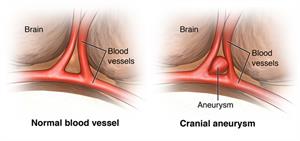Artery Bypass and Occlusion for Brain Aneurysms
What is artery bypass and occlusion?
Artery bypass and occlusion is a two-part procedure to manage brain (cerebral) aneurysms.
In the first part of the procedure, the surgeon re-routes (bypasses) blood flow around the aneurysm.
The second part closes down (occludes) the aneurysm balloon itself and the surrounding portion of the weakened artery with a coil.
How is bypass and occlusion performed?
Bypass, the first part of the procedure, is performed to use other blood vessels in your body to direct blood flow away from the aneurysm so that your surgeon can safely close it.
Using precise instruments, your surgeon detaches one end of another blood vessel in the brain. This is called a donor vessel, and it is chosen beforehand.
Next, the donor vessel is rerouted into a position beyond the aneurysm and reconnected to the parent vessel to ensure that blood continues to flow to the part of the brain that needs it.
After the bypass, the surgeon closes, or occludes, the diseased portion of the blood vessel where the aneurysm is located. The surgeon inserts tiny coils into the diseased vessel until it is completely filled. The coils remain inside the brain permanently.
Dr. Olachi Mezu suffered — and survived — a ruptured brain aneurysm
Dr. Olachi Mezu suffered a ruptured brain aneurysm while traveling from New York to her home in Maryland. Watch her story as she talks about the care and treatment she received from Johns Hopkins and her neurosurgeon Dr. Judy Huang.




